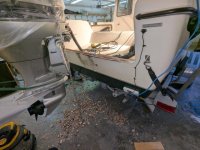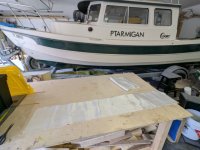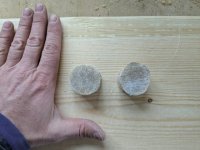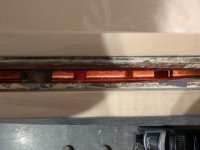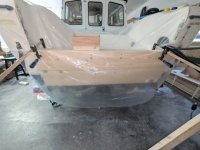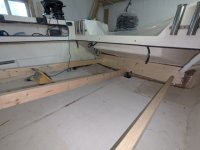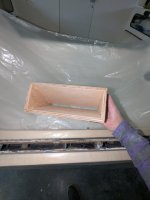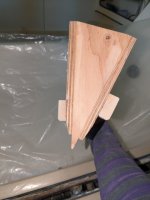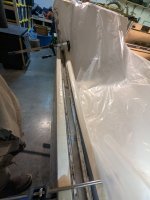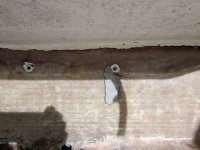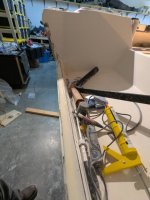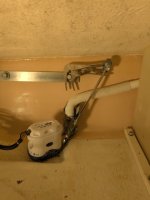Ctarmigan
Member
- Joined
- Nov 14, 2019
- Messages
- 54
- Reaction score
- 0
- C Dory Year
- 2004
- C Dory Model
- 22 Cruiser
- Hull Identification Number
- CD022102J304
- Vessel Name
- Ptarmigan
Work is progressing. I'm removing balsa core via the open top of the transom, and while its tedious it's not impossible. The advice on a spade bit was good; that's been a helpful tool. A few DIY pry-bar/chisel tools have also been helpful.
The sole setback; I managed in a couple of cases to punch through the inner transom skin below the splashwell with the spade bit. The skin here is surprisingly thin - I'd estimate 2-3mm - and therefore more delicate than I'd anticipated.
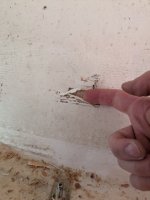
I'm forming a plan for recoring, based on my forecast abilities and accessible materials. I'm looking to remove all transom core, and replace with CarbonBond pourable transom compound (formerly NidaBond).
A discussion with one of their techs suggested that moderate prep of the transom skins would lead to a solid bond between CarbonBond and transom fiberglass (recommended sand and wash with alcohol, with a few remaining balsa fibers acceptable). The tech didn't have undue concern about the meeting of CarbonBond and any damp balsa 'around the corner' at the transom/hull junction, other than it would be unlikely to make a solid bond to that balsa.
Given I've already put a couple of (admittedly small) holes in the inner transom skin, I'm considering going a step farther, and removing the majority of the inner skin, leaving a ~2" margin around the edges for ease of replacement. This would allow easier access to remove the remaining balsa, and give that otherwise-inaccessible lower transom area a better sand/clean prep for CarbonBond adhesion. I'd either replace the skin with a new panel before pouring, or make a temporary dam to seal the gap where the panel was removed, pour CarbonBond within the temporarily sealed transom, then apply fiberglass on the cured CarbonBond surface once I'd removed the dam. I'd need a bit more thought before landing on how exactly to pull this off - it's certainly the more involved option (for my level of fiberglass experience).
The sole setback; I managed in a couple of cases to punch through the inner transom skin below the splashwell with the spade bit. The skin here is surprisingly thin - I'd estimate 2-3mm - and therefore more delicate than I'd anticipated.

I'm forming a plan for recoring, based on my forecast abilities and accessible materials. I'm looking to remove all transom core, and replace with CarbonBond pourable transom compound (formerly NidaBond).
A discussion with one of their techs suggested that moderate prep of the transom skins would lead to a solid bond between CarbonBond and transom fiberglass (recommended sand and wash with alcohol, with a few remaining balsa fibers acceptable). The tech didn't have undue concern about the meeting of CarbonBond and any damp balsa 'around the corner' at the transom/hull junction, other than it would be unlikely to make a solid bond to that balsa.
Given I've already put a couple of (admittedly small) holes in the inner transom skin, I'm considering going a step farther, and removing the majority of the inner skin, leaving a ~2" margin around the edges for ease of replacement. This would allow easier access to remove the remaining balsa, and give that otherwise-inaccessible lower transom area a better sand/clean prep for CarbonBond adhesion. I'd either replace the skin with a new panel before pouring, or make a temporary dam to seal the gap where the panel was removed, pour CarbonBond within the temporarily sealed transom, then apply fiberglass on the cured CarbonBond surface once I'd removed the dam. I'd need a bit more thought before landing on how exactly to pull this off - it's certainly the more involved option (for my level of fiberglass experience).

